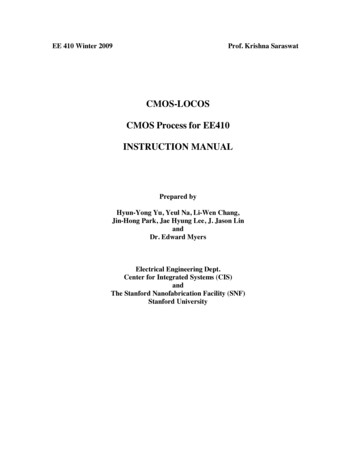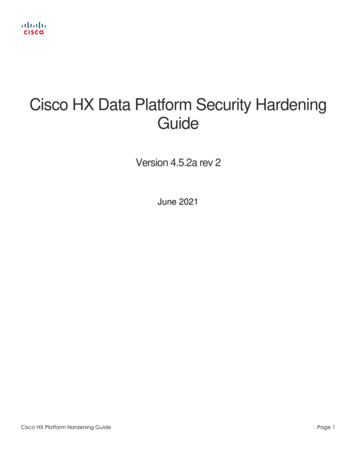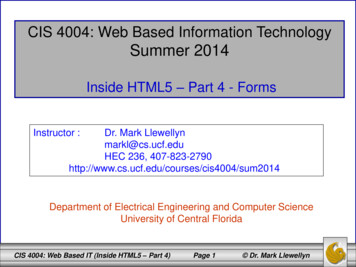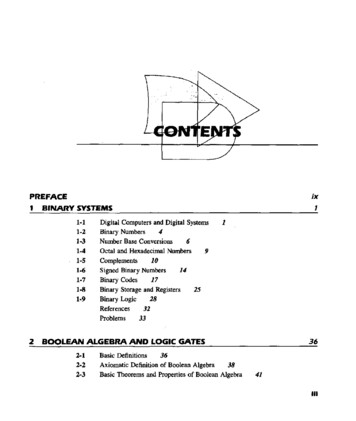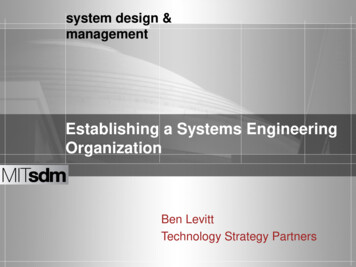
Transcription
Today’s Agenda Course overview and administriviaCIS 371Digital Systems Organization and DesignComputer What is computer organization anyway? and the forces that drive it Motivational experimentsUnit 1: IntroductionSlides developed by Milo Martin & Amir Roth at the University of Pennsylvaniawith sources that included University of Wisconsin slidesby Mark Hill, Guri Sohi, Jim Smith, and David Wood.CIS 371: Computer Organization Prof. Milo Martin Introduction1CIS 371: Computer Organization Prof. Milo Martin Introduction2Pervasive Idea: Abstraction and Layering Abstraction: only way of dealing with complex systems Divide world into objects, each with an Interface: knobs, behaviors, knobs behaviors Implementation: “black box” (ignorance apathy) Only specialists deal with implementation, rest of us with interface Example: car, only mechanics know how implementation worksCourse Overview Layering: abstraction discipline makes life even simpler Divide objects in system into layers, layer n objects Implemented using interfaces of layer n – 1 Don’t need to know interfaces of layer n – 2 (sometimes helps) Inertia: a dark side of layering Layer interfaces become entrenched over time (“standards”)– Very difficult to change even if benefit is clear (example: Digital TV) Opacity: hard to reason about performance across layersCIS 371: Computer Organization Prof. Milo Martin Introduction3CIS 371: Computer Organization Prof. Milo Martin Introduction4
Abstraction, Layering, and ComputersAppAppAppSystem softwareMemCPUI/OCIS 240: Abstraction and Layering Build computer bottom up by raising level of abstractionSoftwareISA Solid-state semi-conductor materials transistors Transistors gates Gates digital logic elements: latches, muxes, addersHardwareTransistors Computers are complex, built in layers Key insight: number representation Several software layers: assembler, compiler, OS, applications Instruction set architecture (ISA) Several hardware layers: transistors, gates, CPU/Memory/IO Logic elements datapath control processor 99% of users don’t know hardware layers implementation 90% of users don’t know implementation of any layer That’s okay, world still works just fine But sometimes it is helpful to understand what’s “under the hood”CIS 371: Computer Organization Prof. Milo Martin Introduction5Beyond CIS 240App240AppAppSystem softwareMemCPUI/O Key insight: stored program (instructions just another form of data) Another one: few insns can be combined to do anything (software) Assembly language high-level language Code graphical user interfaceCIS 371: Computer Organization Prof. Milo Martin Introduction6Why Study Hardware? Understand where computers are going330, 341, 350, 390, 391, 534, 380 Future capabilities drive the (computing) world Real world-impact: no computer architecture no computers! Understand high-level design concepts371 The best system designers understand all the levels Hardware, compiler, operating system, applications CIS 240: Introduction to Computer Systems Understand computer performance Bottom-up overview of the entire hardware/software stack Subsequent courses look at individual pieces in more detail Writing well-tuned (fast) software requires knowledge of hardware Write better software CIS 380: Operating Systems The best software designers also understand hardware Understand the underlying hardware and its limitations A closer look at system level software CIS 277, 330, 341, 350, 390, 391, 455, 460, 461, 462 Design hardware A closer look at different important application domains Intel, AMD, IBM, ARM, Qualcomm, Apple, Oracle, NVIDIA, Samsung, CIS 371: Computer Organization and Design A closer look at hardware layersCIS 371: Computer Organization Prof. Milo Martin Introduction7CIS 371: Computer Organization Prof. Milo Martin Introduction8
Penn LegacyHardware Aspect of CIS 240 vs. CIS 371 ENIAC: electronic numerical integrator and calculator Hardware aspect of CIS 240 First operational general-purpose stored-program computer Designed and built here by Eckert and Mauchly Go see it (Moore building) Focus on one toy ISA: LC4Focus on functionality: “just get something that works”Instructive, learn to crawl before you can walkNot representative of real machines: 240 hardware is circa 1975 First seminars on computer design Moore School Lectures, 1946 “Theory and Techniquesfor Design of ElectronicDigital Computers” CIS 371 De-focus from any particular ISA during lectures Focus on quantitative aspects: performance, cost, power, etc.CIS 371: Computer Organization Prof. Milo Martin Introduction9CIS 371 TopicsCIS 371: Computer Organization Prof. Milo Martin Introduction10Course Goals Review of CIS 240 level hardware Instruction set architecture Single-cycle datapath and control Understand key hardware concepts Pipelining, parallelism, caching, locality, abstraction, etc. New Performance, cost, and technologyFast arithmeticPipelining and superscalar executionMemory hierarchy and virtual memoryMulticorePower & energyCIS 371: Computer Organization Prof. Milo Martin Introduction Three primary goals11 Hands-on design lab A bit of scientific/experimental exposure and/or analysis Not found too many other places in the major My role: Trick you into learning somethingCIS 371: Computer Organization Prof. Milo Martin Introduction12
CIS371 AdministriviaThe CIS371 Lab Instructor Lab project Prof. Milo Martin (milom@cis), Levine 606 “Build your own processor” (pipelined 16-bit CPU for LC4) Use Verilog HDL (hardware description language) Programming language compiles to gates/wires not insns Implement and test on FPGA (field-programmable gate array) Instructive: learn by doing Satisfying: “look, I built my own processor” “Lecture” TA Laurel Emurian “Lab” TAs Mishal Awadah, Jinyan Cao, Connie Ho, Jason Mow,Allison Pearce, Alex Zhang Contact e-mail: No scheduled “lab sessions” cis371@cis.upenn.edu But you’ll need to use the hardware in the lab for the projects Lectures Please do not be disruptive (I’m easily distracted as it is)CIS 371: Computer Organization Prof. Milo Martin Introduction13CIS 371: Computer Organization Prof. Milo Martin IntroductionLab LogisticsCIS371 Resources K-Lab: Moore 204 Three different web sites14 Course website: syllabus, schedule, lecture notes, assignments http://www.cis.upenn.edu/ cis371/ “Piazza”: announcements, questions & discussion https://piazza.com/class#spring2013/cis371 The way to ask questions/clarifications Can post to just me & TAs or anonymous to class As a general rule, no need to email me directly Please sign up! “Canvas”: grade book, turning in of assignments https://upenn.instructure.com Home of the boards, computers, and later in semester you Good news/bad news: 24 hour access, keycode for door lock “Lab” TA office hours, project demos here, too Tools Digilent XUP-V2P boards Xilinx ISE Warning: all such tools notorious for being buggy and fragile Logistics Textbook All projects must run on the boards in the lab Boards and lockers handout sometime in next few weeks P H, “Computer Organization and Design”, 4th edition? ( 80) New this year: available online from Penn library! https://proxy.library.upenn.edu/login?url http://site.ebrary.com/lib/upenn/Top?id 10509203 Course will largely be lecture note drivenCIS 371: Computer Organization Prof. Milo Martin Introduction15CIS 371: Computer Organization Prof. Milo Martin Introduction16
Large Class SizeCoursework (1 of 2) Question: CIS371 keeps growing, how are we going tohandle so many students in a project-based class? A few homework assignments – individual work Written questions Two total “grace” periods, hand in late, no questions asked 48 hour extension Max of one late period per assignment Answer: we’ll do the best we can Just one instructor, one lecture TA, but we have six “lab TAs”. Why? so solutions can posted promptly Labs – all done in groups of 3 students We’ll need your help! Post questions on Piazza, so others can see responses Only use email for private & non-technical sort of issues Help out by answering other student’s questions on Piazza Work in the labs during “lab hours” when TAs are present Come to class on time to avoid disrupting others Start labs & homework assignments earlyCIS 371: Computer Organization Prof. Milo Martin Introduction17LabLabLabLabLab0:1:2:3:4:getting started, tools introarithmetic unitsingle-cycle LC4 & register filesingle-cycle with “cache” (tentative plan)pipelined LC4: bypassing, branch prediction, with cacheCIS 371: Computer Organization Prof. Milo Martin IntroductionCoursework (2 of 2)Grading Exams A necessary evil Tentative grade contributions: In-class midterm (time & date yet to be determined) Cumulative final exam (time & date set by registrar)18 Exams: 50% Midterm: 17% Final: 33% Labs: 35% Homework assignments: 9% Class participation: 1% [Last year] Attend two research seminars I’m looking into who is visiting this semester Class participation Historical grade distribution: median grade is B 2012: A’s: 42%, B’s: 49%, C’s: 7%, D/F’s: 2% 2011: A’s: 40%, B’s: 50%, C’s: 7%, D/F’s: 3%CIS 371: Computer Organization Prof. Milo Martin Introduction19CIS 371: Computer Organization Prof. Milo Martin Introduction20
Academic MisconductFull Disclosure Cheating will not be tolerated Potential sources of bias or conflict of interest Most of my funding governmental (your tax at work) General rule: National Science Foundation (NSF), DARPA, ONR Anything with your name on it must be YOUR OWN work Example: individual work on homework assignments My non-governmental sources of research funding NVIDIA (sub-contract of large DARPA project, ended last year) Intel Sun/Oracle (hardware donation) Possible penalties Zero on assignment (minimum)Fail courseNote on permanent recordSuspensionExpulsion Consulting Qualcomm Sabbatical for 2013-2014 academic year Google Collaborators and colleagues Penn’s Code of Conduct Intel, IBM, AMD, Oracle, Microsoft, Google, VMWare, ARM, etc. (Just about every major computer hardware company) http://www.vpul.upenn.edu/osl/acadint.htmlCIS 371: Computer Organization Prof. Milo Martin Introduction21Recap: CIS 371 in ContextCIS 371: Computer Organization Prof. Milo Martin Introduction22Computer Science as an EstuaryEngineering Prerequisite: CIS 240DesignHandling complexityReal-world impactExamples: Internet,microprocessor Absolutely required as prerequisite Focused on “function” Exposure to logic gates and assembly language programming The “lecture” component of the course:Where does CIS371 fit into computer science?most engineering, some scienceScience Mostly focuses on “performance” Some coverage of “experimental evaluation”Mathematics The “lab” component of the course:Limits of computationAlgorithms & analysisCryptographyLogicProofs of correctness Focuses on “design” Design a working processorExperimentsHypothesisExamples:Internet behavior,Protein-folding supercomputerHuman/computer interactionOther IssuesPublic policy, ethics, law, securityCIS 371: Computer Organization Prof. Milo Martin Introduction23CIS 371: Computer Organization Prof. Milo Martin Introduction24
FAQs Question: Why is the course (and labs) so difficult? [3.41 out of 4 for “difficulty”, 3.42 for “work required”]Some CIS 371(In)Frequently Asked Questions(FAQs) Answer: The final lab is just complicated enough to that it cannot be solved via“brute force” alone Pushes design & debugging skills beyond what you’ve done so far “ there were a few times that it took several hours to find just oneerror in our code.” -- 2012 course eval. comment Often more time consuming than “difficult” Question: Ok, then why are they so time consuming? Time spent varies widely from group-to-group Solid design & careful debugging makes a huge difference Another unfortunate reason: the tools are buggy We’re working on some ways to mitigate that this year Much time is spent the last few weeks (when everyone is busy)CIS 371: Computer Organization Prof. Milo Martin Introduction25CIS 371: Computer Organization Prof. Milo Martin Introduction26Comments from 2012 Course Evals.Comments from 2012 Course Evals. “Is this course some sort of a military exercise tryingto test us if we can survive in extreme situations?Given that every semester, the labs become longerand harder at some point I expect that students'health will get damaged. You should see that peopleeat junk food and drink a lot of RedBulls and Monsterswhich already does damage your body. This is notokay, think about it.” “I learned more from this course, especially theproject, than anything else I’ve taken so far.” “I didn't think there could be a class better thanCIS 240, and from a "fun" perspective I stillbelieve that, but from an academic perspective Ihave learned more in CIS 371 than any othersingle class that I have had at Penn.” “Though I found the course to be extremely valuableand interesting, the amount of work required is veryhigh, especially in the final month”CIS 371: Computer Organization Prof. Milo Martin Introduction27CIS 371: Computer Organization Prof. Milo Martin Introduction28
Comments from 2012 Course Evals.FAQs “You will come out of this course with a much Question: If the labs are so difficult, why aren’t they worth alarger percent of the course grade?better understanding of what a computer is, howit is made, and how it actually works. Was buildinga pipelined processor easy? No. Did I spend a lotof nights-into-mornings in the KLab debugging?Yes. Was it worth it? Definitely.“ “It would be much nicer if the lab, which requires 20-60 hours, beworth much more than 30%, while exams could be weighted lower.”– 2012 course evaluation comment Answer: Group nature of labs & grade uniformity/distribution That is, the lab grades are uniform, what varies is time spent Material covered in lectures is important, too Bigger picture answer: You’ll learn a lot from the labs; learning by doing(no matter how much they are “worth” grade-wise) Again, grades not the main focus; my goal is provide anenvironment that tricks you into learningCIS 371: Computer Organization Prof. Milo Martin Introduction29CIS 371: Computer Organization Prof. Milo Martin IntroductionFAQsSo, Should I Really Take CIS371? Question: if CIS371 is so hard, why do students generallylike it? Are you a Junior/Senior BSE CIS or CMPE major? Answer: Are you a Sophomore BSE CIS or CMPE major? Not sure. I dunno, maybe stockholm syndrome? “Stockholm syndrome, or capture-bonding, is a psychologicalphenomenon in which hostages express empathy, sympathy andhave positive feelings towards their captors, sometimes to thepoint of defending them.” – wikipedia30 Welcome aboard, please fasten your seatbelts Did you really excel at CIS 240? If not, take it next year Are you a CIS BAS, BA, or minor? Not required, right? Are you really sure you want to take CIS371? Or, maybe students did learn a thing or two about a thing or twoCIS 371: Computer Organization Prof. Milo Martin Introduction31CIS 371: Computer Organization Prof. Milo Martin Introduction32
Should I Really Take CIS371?Any other questions?Red pill or blue pill?CIS 371: Computer Organization Prof. Milo Martin Introduction33CIS 371: Computer Organization Prof. Milo Martin Introduction34“Computer Organization” “Digital Systems Organization and Design” Don’t really care about “digital systems” in general “Computer Organization and Design” Computer architecture Definition of ISA to facilitate implementation of software layers The hardware/software interfaceWhat is Computer Organization? Computer micro-architecture Design processor, memory, I/O to implement ISA Efficiently implementing the interface CIS 371 is mostly about processor micro-architecture Confusing: architecture also means micro-architectureCIS 371: Computer Organization Prof. Milo Martin Introduction35CIS 371: Computer Organization Prof. Milo Martin Introduction36
What is Computer Architecture?What is Computer Architecture? “Computer Architecture is the science and art of selectingand interconnecting hardware components to createcomputers that meet functional, performance and costgoals.” - WWW Computer Architecture Page An analogy to architecture of buildings CIS 371: Computer Organization Prof. Milo Martin Introduction37What is Computer Architecture?The role of a computer architect:ComputersDesktopsServersMobile PhonesSupercomputersGame onCostSafetyEase of ConstructionEnergy EfficiencyFast Build iumsMuseumsCIS 371: Computer Organization Prof. Milo Martin Introduction38 Age of discipline 60 years (vs. five thousand years) Rate of change All three factors (technology, applications, goals) are changing Quickly Automated mass production Design advances magnified over millions of chipsImportant differences: age ( 60 years vs thousands), rate of change,automated mass production (magnifies design)CIS 371: Computer Organization Prof. Milo Martin mputer Architecture Is Different Manufacturing“Technology”PlansLogic GatesDesignSRAMDRAMGoalsCircuit TechniquesFunctionPackagingPerformanceMagnetic StorageReliabilityFlash MemoryCost/ManufacturabilityEnergy EfficiencyTime to MarketThe role of a building architect:39 Boot-strapping effect Better computers help design next generationCIS 371: Computer Organization Prof. Milo Martin Introduction40
Design Goals & ConstraintsDesign Goals & Constraints Functional Low cost Needs to be correct And unlike software, difficult to update once deployed What functions should it support (Turing completeness aside) Reliable Low power/energyDoes it continue to perform correctly?Hard fault vs transient faultGoogle story - memory errors and sun spotsSpace satellites vs desktop vs server reliability Energy in (battery life, cost of electricity) Energy out (cooling and related costs) Cyclic problem, very much a problem today High performance Challenge: balancing the relative importance of these goals “Fast” is only meaningful in the context of a set of important tasks Not just “Gigahertz” – truck vs sports car analogy Impossible goal: fastest possible design for all programsCIS 371: Computer Organization Prof. Milo Martin IntroductionPer unit manufacturing cost (wafer cost)Cost of making first chip after design (mask cost)Design cost (huge design teams, why? Two reasons )(Dime/dollar joke)41 And the balance is constantly changing No goal is absolutely important at expense of all others Our focus: performance, only touch on cost, power, reliabilityCIS 371: Computer Organization Prof. Milo Martin IntroductionShaping Force: Applications/DomainsMore Recent Applications/Domains Another shaping force: applications (usage and context) Desktop: home office, multimedia, games Applications and application domains have different requirements Domain: group with similar character Lead to different designs Scientific: weather prediction, genome sequencing First computing application domain: naval ballistics firing tables Need: large memory, heavy-duty floating point Examples: CRAY T3E, IBM BlueGene Commercial: database/web serving, e-commerce, Google Need: data movement, high memory I/O bandwidth Examples: Sun Enterprise Server, AMD Opteron, Intel XeonCIS 371: Computer Organization Prof. Milo Martin Introduction42 Need: integer, memory bandwidth, integrated graphics/network? Examples: Intel Core 2, Core i7, AMD Athlon Mobile: laptops, mobile phones Need: low power, integer performance, integrated wireless Laptops: Intel Core 2 Mobile, Atom, AMD Turion Smaller devices: ARM chips by Samsung, Qualcomm; Intel Atom Embedded: microcontrollers in automobiles, door knobs Need: low power, low cost Examples: ARM chips, dedicated digital signal processors (DSPs) Over 6 billion ARM cores sold in 2010 (multiple per phone) Deeply Embedded: disposable “smart dust” sensors Need: extremely low power, extremely low cost43CIS 371: Computer Organization Prof. Milo Martin Introduction44
Application Specific Designs This class is about general-purpose CPUs Processor that can do anything, run a full OS, etc. E.g., Intel Core i7, AMD Athlon, IBM Power, ARM, Intel Itanium In contrast to application-specific chips Or ASICs (Application specific integrated circuits) Also application-domain specific processors Implement critical domain-specific functionality in hardware Examples: video encoding, 3D graphics General rules- Hardware is less flexible than software Hardware more effective (speed, power, cost) than software Domain specific more “parallel” than general purpose But general mainstream processors becoming more parallelTechnology Trends Trend: from specific to general (for a specific domain)CIS 371: Computer Organization Prof. Milo Martin Introduction45Constant Change: Technology“Technology”Logic GatesSRAMDRAMCircuit TechniquesPackagingMagnetic StorageFlash facturabilityEnergy EfficiencyTime to MarketCIS 371: Computer Organization Prof. Milo Martin DesktopServersMobile PhonesSupercomputersGame ConsolesEmbedded Absolute improvement, different rates of change New application domains enabled by technology advancesCIS 371: Computer Organization Prof. Milo Martin Introduction Basic elementgate Solid-state transistor (i.e., electrical switch) source Building block of integrated circuits (ICs) What’s so great about ICs? Everythingdrainchannel High performance, high reliability, low cost, low power Lever of mass production Several kinds of integrated circuit families SRAM/logic: optimized for speed (used for processors)DRAM: optimized for density, cost, power (used for memory)Flash: optimized for density, cost (used for storage)Increasing opportunities for integrating multiple technologies Non-transistor storage and inter-connection technologies Disk, optical storage, ethernet, fiber optics, wireless47CIS 371: Computer Organization Prof. Milo Martin Introduction48
Moore’s Law - 1965Funny or Not Funny?CIS 371: Computer Organization Prof. Milo Martin Introduction23049Today:transistorsCIS 371: Computer Organization Prof. Milo Martin Introduction50Technology TrendsTechnology Change Drives Everything Moore’s Law Computers get 10x faster, smaller, cheaper every 5-6 years! Continued (up until now, at least) transistor miniaturization A 10x quantitative change is qualitative change Plane is 10x faster than car, and fundamentally different travel mode Some technology-based ramifications Absolute improvements in density, speed, power, costsSRAM/logic: density: 30% (annual), speed: 20%DRAM: density: 60%, speed: 4%Disk: density: 60%, speed: 10% (non-transistor)Big improvements in flash memory and network bandwidth, too New applications become self-sustaining market segments Recent examples: mobile phones, digital cameras, mp3 players, etc. Low-level improvements appear as discrete high-level jumps Capabilities cross thresholds, enabling new applications and uses Changing quickly and with respect to each other!! Example: density increases faster than speed Trade-offs are constantly changing Re-evaluate/re-design for each technology generationCIS 371: Computer Organization Prof. Milo Martin Introduction51CIS 371: Computer Organization Prof. Milo Martin Introduction52
Revolution I: The MicroprocessorFirst Microprocessor Microprocessor revolution Intel 4004 (1971) One significant technology threshold was crossed in 1970sEnough transistors ( 25K) to put a 16-bit processor on one chipHuge performance advantages: fewer slow chip-crossingsEven bigger cost advantages: one “stamped-out” component Microprocessors have allowed new market segments Desktops, CD/DVD players, laptops, game consoles, set-top boxes,mobile phones, digital camera, mp3 players, GPS, automotive Application: calculators Technology: 10000 nm 2300 transistors13 mm2108 KHz12 Volts 4-bit data Single-cycle datapath And replaced incumbents in existing segments Microprocessor-based system replaced supercomputers,“mainframes”, “minicomputers”, etc.CIS 371: Computer Organization Prof. Milo Martin Introduction53CIS 371: Computer Organization Prof. Milo Martin IntroductionPinnacle of Single-Core MicroprocessorsTracing the Microprocessor Revolution Intel Pentium4 (2003) How were growing transistor counts used? Application: desktop/server Technology: 90nm (1/100x) 55M transistors (20,000x)101 mm2 (10x)3.4 GHz (10,000x)1.2 Volts (1/10x) 32/64-bit data (16x)22-stage pipelined datapath3 instructions per cycle (superscalar)Two levels of on-chip cachedata-parallel vector (SIMD) instructions, hyperthreadingCIS 371: Computer Organization Prof. Milo Martin Introduction54 Initially to widen the datapath 4004: 4 bits Pentium4: 64 bits and also to add more powerful instructions To amortize overhead of fetch and decode To simplify programming (which was done by hand then)55CIS 371: Computer Organization Prof. Milo Martin Introduction56
Revolution II: Implicit ParallelismPinnacle of Single-Core Microprocessors Then to extract implicit instruction-level parallelism Intel Pentium4 (2003) Hardware provides parallel resources, figures out how to use them Software is oblivious Initially using pipelining Which also enabled increased clock frequency caches Which became necessary as processor clock frequency increased and integrated floating-pointThen deeper pipelines and branch speculationThen multiple instructions per cycle (superscalar)Then dynamic scheduling (out-of-order execution) Application: desktop/server Technology: 90nm (1/100x) 55M transistors (20,000x)101 mm2 (10x)3.4 GHz (10,000x)1.2 Volts (1/10x) 32/64-bit data (16x)22-stage pipelined datapath3 instructions per cycle (superscalar)Two levels of on-chip cachedata-parallel vector (SIMD) instructions, hyperthreading We will talk about these thingsCIS 371: Computer Organization Prof. Milo Martin Introduction57CIS 371: Computer Organization Prof. Milo Martin Introduction58Modern Multicore ProcessorRevolution III: Explicit Parallelism Intel Core i7 (2009) Then to support explicit data & thread level parallelism Hardware provides parallel resources, software specifies usage Why? diminishing returns on instruction-level-parallelism Application: desktop/server Technology: 45nm (1/2x) 774M transistors (12x)296 mm2 (3x)3.2 GHz to 3.6 Ghz ( 1x)0.7 to 1.4 Volts ( 1x) 128-bit data (2x)14-stage pipelined datapath (0.5x)4 instructions per cycle ( 1x)Three levels of on-chip cachedata-parallel vector (SIMD) instructions, hyperthreadingFour-core multicore (4x)CIS 371: Computer Organization Prof. Milo Martin Introduction First using (subword) vector instructions , Intel’s SSE One instruction does four parallel multiplies and general support for multi-threaded programs Coherent caches, hardware synchronization primitives Then using support for multiple concurrent threads on chip First with single-core multi-threading, now with multi-core Graphics processing units (GPUs) are highly parallel Converging with general-purpose processors (CPUs)?59CIS 371: Computer Organization Prof. Milo Martin Introduction60
To ponder Technology Disruptions Classic examples: The transistor MicroprocessorIs this decade’s“multicore revolution”comparable to the original“microprocessor revolution”? More recent examples: Multicore processors Flash-based solid-state storage Near-term potentially disruptive technologies: Phase-change memory (non-volatile memory) Chip stacking (also called 3D die stacking) Disruptive “end-of-scaling” “If something can’t go on forever, it must stop eventually” Can we continue to shrink transistors for ever? Even if more transistors, not getting as energy efficient as fastCIS 371: Computer Organization Prof. Milo Martin Introduction61Managing This Mess“Technology”Logic GatesSRAMDRAMCircuit TechniquesPackagingMagnetic StorageFlash Memory Goals/constraints, applications, implementation technology Questions How to deal with all of these inputs? How to manage changes? AnswersAccrued institutional knowledge (stand on each other’s shoulders)Experience, rules of thumbDiscipline: clearly defined end state, keep your eyes on the ballAbstraction and layeringCIS 371: Computer Organization Prof. Milo Martin Introduction62Recap: Constant Change Architect must consider all factors CIS 371: Computer Organization Prof. Milo Martin ost/ManufacturabilityEnergy EfficiencyTime to MarketCIS 371: Computer Organization Prof. Milo Martin le PhonesSupercomputersGame ConsolesEmbedded64
In-Class Exercisewhile (node ! NULL) {!if (node- m data value) {!return node;! Left & right pointers} else if (node- m data value){! Integer value keysnode node- m right;! Initialized to be fully balanced } else {!node node- m left; !}!Question#1:}! Consider a binary tree Experimental Motivation The average lookup time for tree of size 1024 (1K 210) is 50ns What about for a a tree of size 1,048,576 (1M 220)? Question #2: For each item in a tree, look it up (repeatedly) What is the expected distribution of lookup times over all items For a tree with height
CIS 371: Computer Organization and Design A closer look at hardware layers Mem CPU I/O System software App App App 240 380 330, 341, 350, 390, 391, 534, 371 CIS 371: Computer Organization Prof. Milo Martin Introduction 8 W


